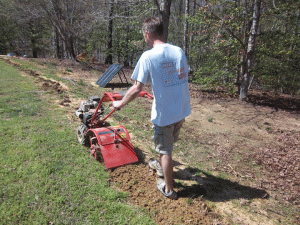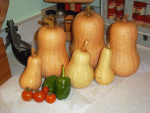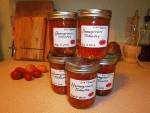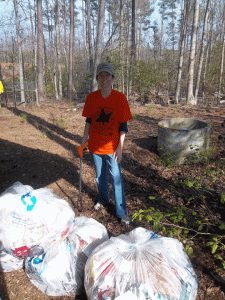My husband Carl built a solar-powered heater with soda cans and materials that we had around the house. Our house is smaller, 1200 sq ft, and with the solar heater installed in one of our living room windows and attached to a fan blower inside the house, it prevents our heat pump from coming on all day on cold days when the sun is out.
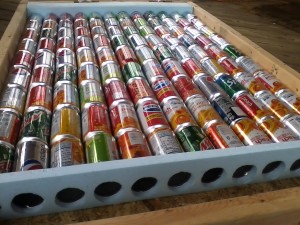
Our solar heater built out of soda cans and materials we had around the house.
How It Works
He put an input hole into the box which allows cooler air from the house to be drawn in and heated as it passes through the cans which have been heated by the sun. The warmer air exits the box and is used to heat the house. (We have a tube coming from the exit hole connected to a fan blower inside the house to cycle air through the box.)
How He Built It
We happened to have 2 old windows to use as the covering for the box, and the size of the heater box was based on the size of the windows. Our heater box is 34″ X 54″. If you want to do this yourself, you could also use a clear corrugated material, or any kind of clear material that lets the sun come in.
Phase 1: He made a 34″ X 54″ basic frame out of a sheet of plywood and 2X4s . He cut two holes in the frame for intake / outtake. Then he cut a coffee can in half and glued them in place.

Phase 1: Wooden frame, 34″ X 54″, with coffee cans in place.
Phase 2: We collected 108+ soda cans! (Yes we drank a lot of soda, and had other people donate them.) We washed out the soda cans and let them dry.

Phase 2: Collect soda cans, make slits in bottoms, and use can opener to remove lids.
Now came the hard part, putting the holes in the botttoms of the soda cans. He used a rotary tool with a cut-off bit to make an X pattern. His bit got worn down, and there’s probably a better way to do it, but that’s what he had on hand. He used the handle-end of a screwdriver the open the whole from the cut X-pattern. Then he used a hand-crank can opener to remove the tops of the soda cans. This worked rather well.
Phase 3:
Next, to secure the cans for the top and bottom, he cut holes in two pieces of foam board so that the tops of the cans fit snugly into the holes.

Phase 3: Top and bottom rows of cans fit into holes made in foam board. The ‘lid’ end of the cans inserted into holes.

Phase 3: Top and bottom rows of cans fit into holes made in foam board. The ‘lid’ end of the cans inserted into holes.
Keep in mind that the heat generated inside the finished box might reach temperatures of over 120 Deg, and in our case we had a small area of the foam which melted.
So if you have other materials that you can use in place of the foam board that can withstand more heat, that would be better. (Ours had just a small amount of damage, and is still doing fine.)
Phase 4: He dry-fit the cans into the middle of the frame, with the cans in the same direction for ease-of-fit. However, the bottom row of cans have their tops fitting into the foam board facing down. He left an even gap at both ends of the frame for air circulation, between the foam board and frame. Next he sealed the bottom gap using a solid piece of foam board. (Do not seal the top end with foam board yet – although next photo shows it sealed.)
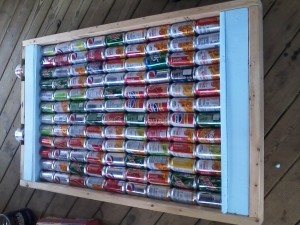
Phase 4 – Dry-fitting the cans, leaving gaps at both end of frame, sealing bottom of frame with solid foamboard
Phase 5: Then he started gluing the cans to the back of board and also gluing cans together to make a seal between them. He used Liquid Nails adhesive.

Phase 5: Cans glued onto the frame, and glued together to create a seal between them.
Phase 6: Placed a piece of foam between intake and outtake to separate the airflow. This is a VERY important step in the overall functionality of the heater. (*Not shown in the picture: Another solid piece of foam board placed over this top-gap)

Intake Baffle
Phase 7: He painted the cans and foam board with a matte black spray paint.
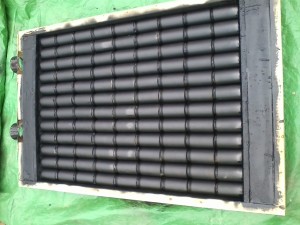
Spray-Painted Cans
Phase 8: He put a bead of liquid Nails all the way around the frame and screwed the windows to the frame. Then the window frames and entire unit was painted with an outdoor black latex paint.

 It was a lot of hard work but it was a lot of fun to build and is showing some great results. If you have any questions, my husband Carl will be happy to answer. He is on this blog as well.
It was a lot of hard work but it was a lot of fun to build and is showing some great results. If you have any questions, my husband Carl will be happy to answer. He is on this blog as well.
AND THE WORKING FINISHED PRODUCT…
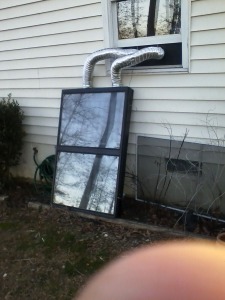
Finished Solar Heater


